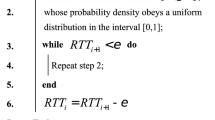Abstract
The buffering in Mobile Ad hoc Networks (MANETs) will depend on end-to-end delay of every user’s information from the arrival time of the resource node which is waiting for the receiving time-span of the destination node. Normally each base station will act as relay node or repeater for different mobile nodes as well as for different base stations. Deployment of base station in the MANET is also a critical research. Each base station contain large number of nodes which is connected based on peer-to- peer communications. Dynamic queuing method is used to share the traffic load to various paths which are selected according to the least buffer size; that increases the packet delivery of the network. Dynamic queuing method is used to reduce the overall waiting time of the packets in the network. In this paper, we propose Buffer Enabled Ad hoc On-demand Multipath Distance Vector (BE-AOMDV) algorithm, that generates the routing protocol with Bernoulli model and find that the packet information minimizes the average end-to-end delay. By using periodic updates on the buffer information of the nodes in the paths, the nodes can take dynamic decisions regarding the help of better routes in the data transmission which can lead to even better use of resources of the network. Buffer Enable Multipath Routing is compared with other multipath routing techniques. Furthermore, using perceptive simplifications, we find that the effect of buffers in networks increases the throughput although incongruously considering average end-to-end delay. During widespread simulations, our simulation results proved that the network with the appearance of data stream circumstance improves using Bernoulli function and the proposed method has the increased throughput compared to other related methods.





















Similar content being viewed by others
References
Robinson, Y. H., Julie, E. G., Balaji, S., & Ayyasamy, A. (2016). Energy aware clustering scheme in wireless sensor network using neuro-fuzzy approach. Wireless Personal Communications, 95, 703–721. https://doi.org/10.1007/s11277-016-3793-8.
Long, N. T., Thuy, N. D., & Hoang, P. H. (2015). Research on applying hierarchical clustered based routing technique using artificial intelligence algorithms for quality of service of service based routing. Internet Things Cloud Comput, 3, 14–21. https://doi.org/10.11648/j.iotcc.s.2015030601.11. (Special Issue: Quality of Service of Service Based Routing).
Govindarajan, J., Vibhurani, N., & Kousalya, G. (2015). An analysis on TCP packet reordering problem in mobile ad-hoc network. Indian Journal of Science and Technology, 8(16).
Bora, K., & Wendi, H. (2015). Cooperative load balancing and dynamic channel allocation for cluster based mobile ad hoc networks. IEEE Transactions on Mobile Computing, 14(5), 951–963.
Zhang, X. M., et al. (2015). Interference-based topology control algorithm for delay-constrained mobile ad hoc networks. IEEE Transactions on Mobile Computing, 14(4), 742–754.
Shukla, A. K., Jha, C. K., & Mishra, V. K. (2014). Building of a competent mobility model for ad hoc wireless networks. In: Proceedings of the Third International Conference on Soft Computing for Problem Solving, Advances in Intelligent Systems and Comoputing (SocPros 2014) (pp. 653–666). India: Springer.
Balaji, S., Julie, E. G., & Robinson, Y. H. (2017). Development of fuzzy based energy efficient cluster routing protocol to increase the lifetime of wireless sensor networks. Mobile Networks and Applications. https://doi.org/10.1007/s11036-017-0913-y.
Host-Madsen, A., & Zhang, J. (2005). Capacity bounds and power allocation for wireless relay channels. IEEE Transactions on Information Theory, 51(6), 2020–2040.
Azarian, K., El Gamal, H., & Schniter, P. (2005). On the achievable diversity-multiplexing tradeoff in half-duplex cooperative channels. IEEE Transactions on Information Theory, 51(12), 4152–4172.
Zhang, D., Tao, X., Lu, J., Zhang, D., Tao, X., Lu, J., et al. (2011). Dynamic resource allocation for real-time services in cooperative OBEMA systems. IEEE Communications Letters, 15, 497–499.
Zhang, D., Wang, Y., & Lu, J. (2010). Qos aware relay selection and subcarrier allocation in cooperative OBEMA systems. IEEE Communications Letters, 14, 294–296.
Zlatanov, N., & Schober, R. (2013). Buffer-aided relaying with adaptive link selection-fixed and mixed rate transmission. IEEE Transactions on Information Theory, 59, 2816–2840.
Xia, B., Fan, Y., Thompson, J., & Poor, H. (2008). Buffering in a three-node relay network. IEEE Transactions on Wireless Communications, 7, 4492–4496.
Yang, J., Ran, Y., Chen, S., Li, W., & Hanzo, L. (2015). Online source rate control for adaptive video streaming over HSPA and LTE-style variable bitrate downlink channels. IEEE Transactions on Vehicular Technology, 65, 643–657.
Zhu, R., & Yang, J. (2015). Buffer-aware adaptive resource allocation scheme in LTE transmission systems. EURASIP Journal on Wireless Communications and Networking, 2015, 176.
Jia, J., Wang, X., & Chen, J. (2015). A genetic approach on cross-layer optimization for cognitive radio wireless mesh network under SINR model. Ad Hoc Networks, 27, 57–67.
Dengiz, O., Konak, A., & Smith, A. E. (2011). Connectivity management in mobile ad hoc networks using particle swarm optimization. Ad Hoc Networks, 9(7), 1–15.
Goswami, M. M., Dharaskar, R. V. & Thakare, V. M. (2009). Fuzzy ant colony based routing protocol for mobile ad hoc network. In Proceedings of the International Conference on Computer Engineering and Technology ICCET’09 (Vol. 2, pp. 438–444). Singapore: IEEE.
Hamid, M. A., Alam, M. M., & Hong, C. S. (2012). Design of a QoS-aware routing mechanism for wireless multimedia sensor networks. In: Global Telecommunications Conference (pp. 1–6).
Robinson, Y. H., & Rajaram, M. (2015). Energy-aware multipath routing scheme based on particle swarm optimization in mobile ad hoc networks. The Scientific World Journal, 2015, 1–9. https://doi.org/10.1155/2015/284276.
Manickavelu, D., & Vaidyanathan, R. U. (2014). Particle swarm optimization (PSO)-based node and link lifetime prediction algorithm for route recovery in MANET. EURASIP Journal on Wireless Communications and Networking, 2014, 107.
Author information
Authors and Affiliations
Corresponding author
Additional information
Publisher's Note
Springer Nature remains neutral with regard to jurisdictional claims in published maps and institutional affiliations.
Rights and permissions
About this article
Cite this article
Robinson, Y.H., Balaji, S. & Julie, E.G. Design of a Buffer Enabled Ad hoc On-demand Multipath Distance Vector Routing Protocol for Improving Throughput in Mobile Ad hoc Networks. Wireless Pers Commun 106, 2053–2078 (2019). https://doi.org/10.1007/s11277-018-5925-9
Published:
Issue Date:
DOI: https://doi.org/10.1007/s11277-018-5925-9




